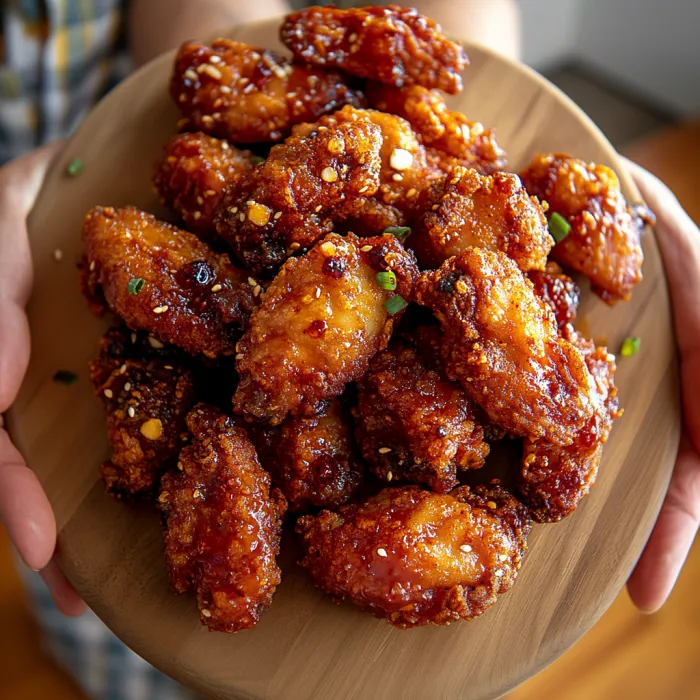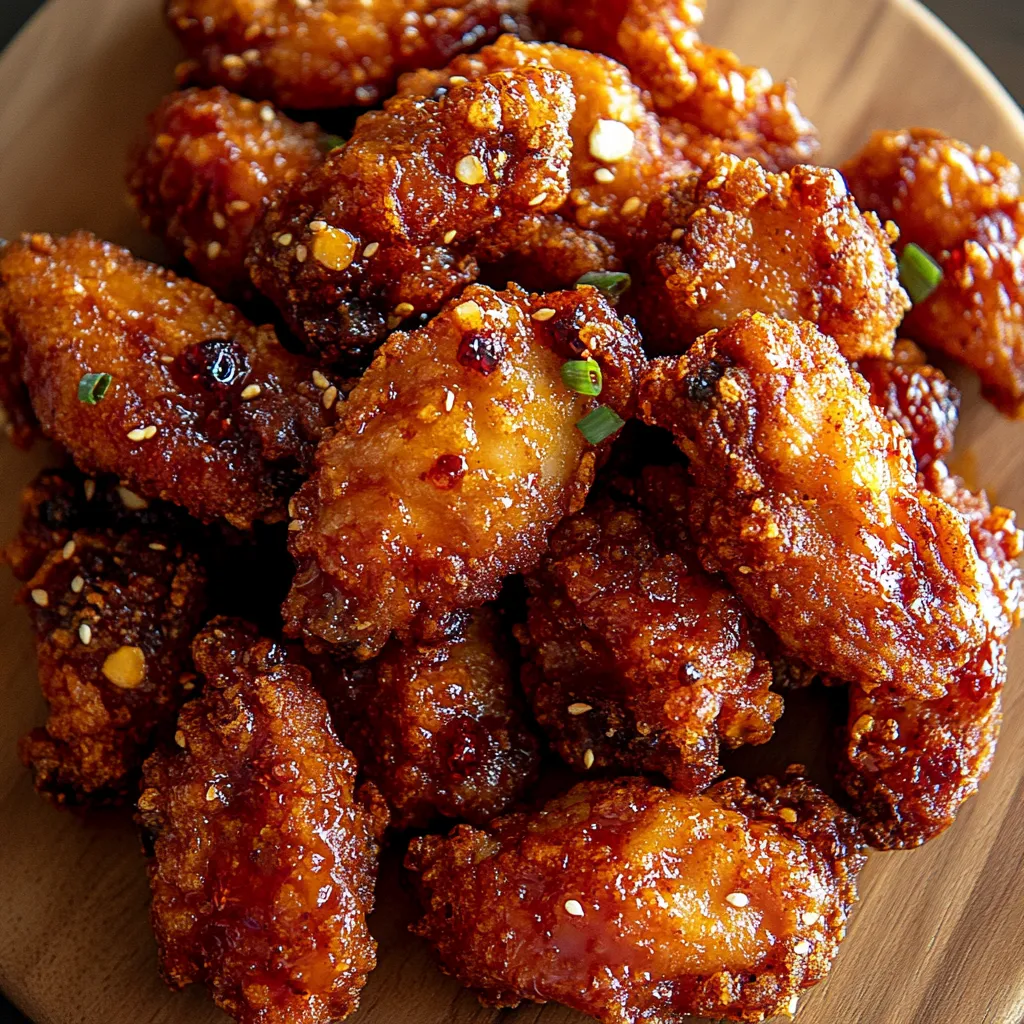 Save
Save
This Korean fried chicken recipe transforms ordinary wings into an addictive crispy delight with a perfect balance of sweet, spicy, and savory flavors. The double-frying technique creates that signature crackly exterior that Korean fried chicken is famous for, while the gochujang glaze adds complex heat that keeps you coming back for more.
I first made this recipe for friends during a weekend getaway, and it quickly became our tradition for every reunion. The sticky fingers and satisfied smiles are worth every minute spent in the kitchen.
Ingredients
- Chicken wings or drumettes These smaller pieces cook more evenly and get extra crispy. Look for fresh rather than frozen for best results.
- Potato starch Creates the signature ultra crispy coating that stays crunchy even after glazing. Cornstarch works in a pinch but potato starch yields superior results.
- Gochujang The star ingredient that gives authentic Korean flavor. This fermented chili paste provides complex sweet heat. Find it in Asian markets or international grocery aisles.
- Honey and brown sugar Balance the spice and create that sticky quality we love. Use good quality honey for best flavor.
- Rice vinegar Adds essential tanginess to cut through the richness. Unseasoned rice vinegar works best here.
- Sesame oil Adds nutty depth to the glaze. Always use toasted sesame oil for maximum flavor impact.
Step-by-Step Instructions
- Prep the Chicken
- Season chicken pieces thoroughly with salt, pepper and garlic powder, ensuring even coverage. Allow the seasoning to penetrate for at least 15 minutes at room temperature. Properly dried chicken with paper towels before seasoning ensures better adherence and crispier results.
- Create the Coating
- Toss chicken pieces in potato starch until each piece is completely and evenly coated with no bare spots. The starch should create a thin, even layer that will expand during frying. Allow the coated chicken to rest for 10 minutes which helps the coating adhere properly during frying.
- First Fry
- Heat oil to exactly 320°F using a thermometer for accuracy. Fry in small batches to maintain oil temperature, cooking for 7 to 8 minutes until the coating is set but not yet golden. This initial fry cooks the chicken through while beginning to develop the crispy exterior. Remove and rest on a wire rack, not paper towels, to maintain crispiness.
- Second Fry
- Increase oil temperature to 375°F, being patient to reach the proper temperature. Fry chicken pieces again for exactly 2 to 3 minutes until deeply golden and audibly crispy. This second fry creates the hallmark crunchy exterior that Korean fried chicken is famous for. The coating should look rough and craggly with maximum surface area.
- Create the Glaze
- Combine all glaze ingredients in a wide pan large enough to eventually hold the chicken. Simmer over medium heat for 3 to 5 minutes, stirring frequently until the sauce coats the back of a spoon. Watch carefully as it thickens quickly at the end and can burn. The glaze should be thick enough to coat the chicken but still be fluid enough to work with.
- Glaze the Chicken
- Working quickly while chicken is still hot, add fried pieces to the pan with glaze. Toss continuously using tongs or by shaking the pan until every piece is thoroughly coated with no dry spots. Add optional dried chilies during this process for extra heat and visual appeal.
 Save
Save
The first time I served this to my Korean neighbor, she declared it better than her favorite restaurant version. The secret is in the patience of the double fry and not rushing the glaze reduction. My family now requests this dish for every special occasion.
Make Ahead Options
While Korean fried chicken is best enjoyed fresh, you can prepare components ahead of time to streamline the cooking process. Season the chicken and prepare the glaze up to 24 hours in advance, storing both in separate airtight containers in the refrigerator. When ready to cook, simply bring the glaze to room temperature while you fry the chicken. For leftovers, store unglazed fried chicken in the refrigerator and reheat in a 375°F oven for 10 minutes until crispy again, then toss with freshly made glaze.
Flavor Variations
The classic gochujang glaze is just the beginning. Try a soy garlic version by omitting the gochujang and increasing garlic to 4 cloves with an additional tablespoon of soy sauce. For a sweeter variation, add 2 tablespoons of apricot jam to the traditional glaze. Lemon pepper enthusiasts will love adding fresh lemon zest and increasing the black pepper. Each variation maintains the essential crispy texture while offering a new flavor profile.
Serving Suggestions
Korean fried chicken traditionally appears alongside pickled radishes which cut through the richness perfectly. Serve with steamed rice to make it a complete meal or offer as part of a larger Korean feast with banchan side dishes. For a fusion approach, serve with crisp vegetable sticks and blue cheese dipping sauce as an alternative to buffalo wings at your next gathering. Always garnish with toasted sesame seeds and sliced green onions for authentic presentation.
Recipe FAQs
- → Can I use cornstarch instead of potato starch?
Yes, cornstarch works as an alternative to potato starch, though potato starch produces an even crispier texture. If using cornstarch, the coating may be slightly less crunchy but will still yield excellent results.
- → Why is the chicken fried twice?
Double-frying is essential for achieving the signature ultra-crispy texture. The first fry at a lower temperature (320°F) cooks the chicken through, while the second fry at a higher temperature (375°F) creates the perfect crispy exterior that stays crunchy even after glazing.
- → How spicy is this dish?
The spice level is moderate and can be adjusted. For milder heat, reduce the gochujang to 1 tablespoon and omit the dried chilies. For extra spice, add more gochujang or include the optional dried chilies when making the glaze.
- → Can I make this with other chicken parts?
Absolutely! While wings and drumettes are traditional, you can use boneless chicken thighs or breast cut into bite-sized pieces. Just adjust the frying time accordingly—boneless pieces may cook faster than bone-in wings.
- → How can I make the glaze thicker?
If your glaze isn't reaching the desired thickness, simmer it longer to reduce further. Alternatively, you can add an additional teaspoon of brown sugar or honey to help it reach that perfect sticky consistency.
- → Can I prepare the glaze ahead of time?
Yes! The glaze can be prepared up to 3 days in advance and stored in an airtight container in the refrigerator. Simply reheat it in a pan before tossing with the freshly fried chicken.
